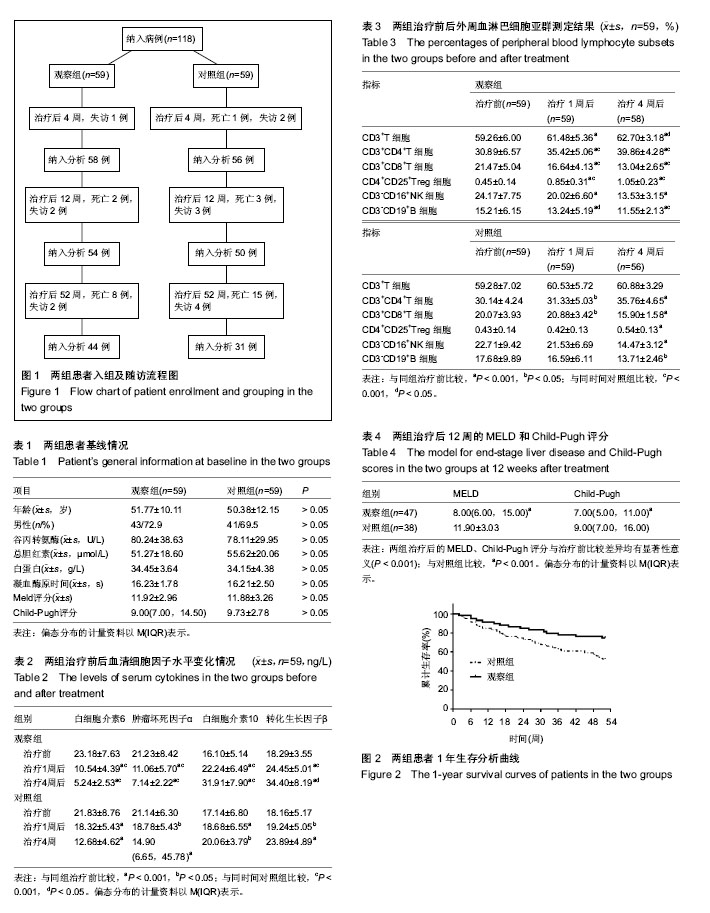| [1] Motawi TM,Atta HM,Sadik NA,et al.The therapeutic effects of bone marrow-derived mesenchymal stem cells and simvastatin in a rat model of liver fibrosis.Cell Biochem Biophys.2014;68(1):111-125.[2] 孙慧聪,张国尊,郭金波,等.脐带源间充质干细胞移植治疗肝纤维化及肝硬化的相关机制[J].中国组织工程研究,2015,19(41): 6638-6645.[3] Glennie S, Soeiro I, Dyson PJ, et al. Bone marrow mesenchymal stem cells induce division arrest anergy of activated T Cells.Blood.2005;105(7):2821-2827. [4] Ghannam S,Pene J,Torcy-Moquet G,et al.Mesenchymal stem cells inhibit human Th17 cell differentiation and function and induce a T regulatory cell phenotype.J Immunol.2010; 185(1):302-312.[5] 曾芝雨,李东良,方坚,等.脐带间充质干细胞联合骨髓干细胞移植治疗失代偿期肝硬化:1年随访对照[J].中国组织工程研究,2015, 19(10):1533-1538.[6] 但刚,金静,吴丽娟,等.脐血干细胞移植治疗肝硬化失代偿后T淋巴细胞亚群的观察[J].国际检验医学志,2011,32(20):2319-2320.[7] Wang L,Han Q,Chen H,et al.Allogeneic bone marrow mesenchymal stem cell transplantation in patients with UDCA-resistant primary biliary cirrhosis.Stem Cells Dev. 2014;23(20):2482-2489.[8] Herencia C,Almadén Y,Martínez-Moreno JM,et al.Human mesenchymal stromal cell lysates as a novel strategy to recover liver function.Regen Med.2015;10(1):25-38.[9] Park M,Kim YH,Woo SY,et al.Tonsil-derived mesenchymal stem cells ameliorate CCl4-induced liver fibrosis in mice via autophagy activation.Sci Rep.2015;5:8616.[10] Sato Y,Araki H,Kato J,et al.Human mesenchymal stem cells xen-ografted directly to rat liver are differentiated into human hepatocytes without fusion.Blood.2005;106(2):756-763.[11] Volarevic V,Nurkovic J,Arsenijevic N,et al.Concise review:Therapeutic potential of mesenchymal stem cells for the treatment of acute liver failure and cirrhosis.Stem Cells.2014;32(11):2818-2823.[12] Eom YW,Shim KW,Baik SK.Mesenchymal stem cell therapy for liver fibrosis. Korean J Intern Med.2015;30:580-589.[13] Di Nicola M,Carlo-stella C,Magni M,et al.Human bone marrow stromal cells supress T- lymphocyte proliferation induced by cellular or nonspecific mitogenic stimuli.Blood.2002;99:3838.[14] Akiyama K,Chen C,Wang D,et al. Mesenchymal-stem-cell- induced immunoregulation involves FAS-ligand/FAS- mediated T cell apoptosis.Cell Stem Cell.2012;10(5):544-555.[15] Franquesa M,Hoogdujn MJ,Bestard O,et al. Immunomodulatory effect of mesenchymal stem cells on B cells. Front.Immunol.2012;3:212. [16] Franquesa M,Mensah EK,Huizinga R,et al.Human adipos tissue-derived mesenchymal stem cells abrogate plasmablast formation and induce regulatory B cells independently of T helper cells. Stem cells.2015;33(3):880-891.[17] Alikarami F, Yari F, Amirizadeh N, et al. The immunosuppressive activity of amniotic membrane mesenchymal stem cells on T lymphocytes.Avicenna J Med Biotechnol.2015;7(3):90-96.[18] Guo CH,Han LX,Wan MR,et al.Immunomodulatory effect of bone marrow mesenchymal stem cells on T lymphocytes in patients with decompensated liver cirrhosis.Genet Mol Res. 2015;14(2):7039-7046.[19] Obermajer N,Popp EC,Soeder Y,et al.Conversion of Th17 into IL-17A(neg) regulatory T cells: a novel mechanism in prolonged allograft survival promoted by mesenchymal stem cell-supported minimized immunosuppressive therapy.J Immunol.2014;193(10):4988-4999.[20] 中华医学会肝病学分会和感染病学分会.慢性乙型肝炎防治指南(2015更新版)[J].中华肝脏病杂志,2015,23(12):888-905.[21] Amin MA,Sabry D,Rashed LA,et al.Short-term evaluation of autologous transplantation of bone marrow-derived mesenchymal stem cells in patients with cirrhosis: Egyptian study.Clin Transplant.2013;27(4):607-612.[22] Jang YO,Kim YJ,Baik SK,et al.Histological improvement following administration of autologous bone marrow-derived mesenchymal stem cells for alcoholic cirrhosis: a pilot study. Liver Int.2014;34(1):33-41.[23] Tang TJ,Kwekkeboom J,Laman JD,et al.The role of intrahepatic immune effector cells in inflammatory liver injury and viral control during chronic hepatitis B infection.J Viral Hepat.2003;10(3):159-167.[24] Zhou L,Lopes JE,Chong MM,et al.TGF-beta-induced Foxp3 inhibits Th17 cell differentiation by antagonizing ROR gamma function.Nature.2008;455:236-240.[25] Banas A,Teratani T,Yamamoto Y,et al.Rapid hepatic fate specification of adipose-derived stem cells and their therapeutic potential for liver failure.J Gastroenterol Hepatol. 2009;24(1):70-77.[26] Chen X,Gan Y,Li W,et al.The interaction between mesenchymal stem cells and steroids during inflammation. Cell Death Dis.2014;5:e1009.[27] Kharaziha P,Hellström PM,Noorinayer B,et al.Improvement of liver function in liver cirrhosis patients after autologous mesenchymal stem cell injection: a phase I-II clinical trial.Eur J Gastroenterol Hepatol.2009;21(10):1199-1205.[28] Gholamrezanezhad A,Mirpour S,Baghern M,et al.In vivo tracking of 111 in-oxine labeled mesenchymal stem cells following infusion in patients with advanced cirrhosis.Nucl Med Biol.2011;38(7):961-967. |
.jpg)

.jpg)